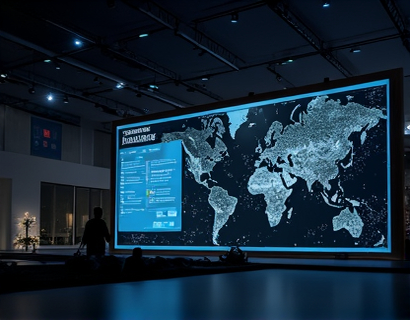Next-Gen QR Code Solutions: Transforming Business and Social Media Engagement for Modern Brands
In the rapidly evolving digital landscape, businesses and social media managers are constantly seeking innovative ways to enhance engagement and streamline information sharing. Next-generation QR Code technology has emerged as a powerful tool, offering customizable and intuitive solutions that significantly improve customer interaction and boost online presence. These advanced QR Codes, often referred to as the next generation of QR Codes, are designed to meet the growing demands of modern brands looking to stand out in a crowded digital environment.
The traditional QR Code, while effective, has limitations that next-gen solutions address. Next-generation QR Codes are more versatile, secure, and user-friendly. They can store a larger amount of data, support dynamic content updates, and integrate seamlessly with various digital platforms. This article delves into how these advanced QR Code solutions are transforming business and social media engagement, providing valuable insights for brands and social media managers aiming to enhance their digital strategies.
Enhanced Data Storage and Dynamic Content
One of the most significant advantages of next-gen QR Codes is their increased data storage capacity. While standard QR Codes can hold up to 7,089 numeric characters or 4,296 alphanumeric characters, next-generation versions can store much more data. This expanded capacity allows businesses to include detailed information such as comprehensive product descriptions, extensive FAQs, and even multimedia content like videos and audio clips. The ability to embed rich, dynamic content makes next-gen QR Codes an invaluable tool for providing customers with a deeper and more engaging experience.
Dynamic QR Codes, in particular, offer real-time updates without the need to regenerate the code. This feature is particularly useful for businesses that frequently update their content, such as promotions, event details, or inventory information. By linking to a central database, dynamic QR Codes ensure that users always receive the most current information, reducing the risk of outdated data and enhancing customer trust.
Improved User Experience and Accessibility
Next-gen QR Codes are designed with user experience in mind. They are more visually appealing and can be customized with various colors, shapes, and logos, making them more brand-friendly and less intrusive. This customization option allows businesses to integrate QR Codes seamlessly into their marketing materials, websites, and physical stores, creating a cohesive and professional look.
Accessibility is another critical aspect of next-gen QR Codes. These advanced codes can be optimized for different devices and environments, ensuring that they are easily scannable on smartphones, tablets, and even smart glasses. This versatility ensures that users have a smooth and consistent experience, regardless of the device they use to scan the code. Additionally, next-gen QR Codes can be designed to work in low-light conditions or when scanned from a distance, further enhancing their practicality.
Security and Trust
Security is a paramount concern in the digital age, and next-gen QR Codes address this by incorporating advanced security features. These codes can include encryption and authentication mechanisms to protect sensitive information and prevent unauthorized access. For businesses handling confidential data, such as financial information or personal identifiers, this added layer of security is crucial in building customer trust and compliance with data protection regulations.
Moreover, the use of secure QR Codes can help brands avoid the negative impact of malicious links and phishing attempts. By ensuring that the content linked to a QR Code is verified and secure, businesses can reduce the risk of damaging their reputation and losing customer confidence.
Enhanced Analytics and Tracking
Next-gen QR Codes offer sophisticated analytics and tracking capabilities that provide valuable insights into user behavior and engagement. Brands can monitor how many times a QR Code is scanned, where the scans originate from, and even track user interactions with the content linked to the code. This data is invaluable for refining marketing strategies, optimizing content, and measuring the effectiveness of campaigns.
Advanced tracking features also enable businesses to segment their audience based on scanning behavior, allowing for more targeted and personalized marketing efforts. By understanding which segments of their audience are most engaged with QR Code content, businesses can tailor their messaging and offers to better resonate with their target market.
Integration with Digital Platforms
The seamless integration of next-gen QR Codes with various digital platforms is a key factor in their effectiveness. These codes can be easily embedded into websites, social media posts, email campaigns, and mobile apps, creating a cohesive and interconnected digital experience. This integration ensures that users can access information quickly and efficiently, regardless of the platform they are using.
For social media managers, next-gen QR Codes can be used to drive traffic to specific posts, events, or landing pages, enhancing engagement and conversion rates. By linking QR Codes to social media profiles or campaigns, brands can encourage users to follow them or participate in interactive activities, fostering a stronger community and brand loyalty.
Use Cases in Business and Social Media
Next-gen QR Code solutions find applications across various industries, each with unique use cases that highlight their versatility and benefits.
In the retail sector, businesses can use QR Codes to provide detailed product information, customer reviews, and special offers. By placing QR Codes on product packaging or in-store displays, retailers can enhance the shopping experience and drive sales. For example, a fashion brand can include a QR Code on a clothing item that links to a video showcasing the garment's design process, materials, and care instructions, adding value and transparency to the purchase decision.
In the hospitality industry, hotels and restaurants can use QR Codes to streamline check-in processes, provide menu information, and offer loyalty rewards. A hotel can place a QR Code on the room door that, when scanned, directs guests to a webpage with local attractions, dining options, and special promotions, enhancing their stay and encouraging repeat visits.
For event organizers, QR Codes can be used for ticketing, registration, and on-site navigation. By scanning a QR Code at the entrance, attendees can quickly access their tickets, event schedules, and maps, reducing lines and improving the overall experience. During the event, QR Codes can be used for live polls, Q&A sessions, and social media interactions, increasing engagement and participation.
In the healthcare sector, QR Codes can be used to provide patients with access to their medical records, appointment schedules, and educational resources. For instance, a clinic can place a QR Code in the waiting area that links to a secure portal where patients can view their test results, schedule follow-up appointments, and communicate with healthcare providers, enhancing patient care and satisfaction.
Challenges and Considerations
While next-gen QR Code solutions offer numerous benefits, there are also challenges and considerations that businesses and social media managers should be aware of. One key challenge is ensuring that the QR Codes are scannable and functional across different devices and environments. Testing the QR Codes in various lighting conditions and with different scanners is essential to ensure a consistent user experience.
Another consideration is the potential for user fatigue if QR Codes are overused or placed in inconvenient locations. To maintain engagement, it's important to use QR Codes strategically and provide clear instructions on how to scan them. Additionally, businesses should ensure that the content linked to the QR Code is relevant and valuable to the user, avoiding the risk of frustrating or confusing the audience.
Privacy concerns also play a role in the adoption of QR Codes. Brands must be transparent about how user data is collected and used, and comply with privacy regulations such as GDPR. By being transparent and respectful of user privacy, businesses can build trust and encourage more frequent use of QR Codes.
Future Trends and Innovations
The future of QR Code technology is exciting, with ongoing innovations poised to further enhance their capabilities and applications. One emerging trend is the integration of augmented reality (AR) with QR Codes. By scanning a QR Code, users can trigger AR experiences that overlay digital information onto the physical world, creating immersive and interactive content. This technology has vast potential in areas such as retail, education, and entertainment.
Another area of development is the use of QR Codes in the Internet of Things (IoT). As more devices become interconnected, QR Codes can serve as a bridge between the physical and digital worlds, providing easy access to device settings, status updates, and control options. This integration can simplify user interactions and enhance the functionality of smart devices.
Blockchain technology is also being explored in conjunction with QR Codes to enhance security and traceability. By storing transaction data on a blockchain, QR Codes can provide an immutable and transparent record of events, making them ideal for supply chain management, authentication, and verification processes.
Conclusion
Next-gen QR Code solutions represent a significant advancement in digital engagement tools, offering businesses and social media managers powerful and flexible ways to connect with their audience. By leveraging enhanced data storage, improved user experience, robust security, and seamless integration with digital platforms, these advanced QR Codes can transform how brands interact with customers and build lasting relationships.
As the digital landscape continues to evolve, embracing next-gen QR Code technology can provide a competitive edge, driving engagement, and fostering innovation. Whether used for retail promotions, event management, or healthcare services, the potential applications are vast and the benefits clear. By staying ahead of the curve and adopting these cutting-edge solutions, businesses and social media managers can ensure their online presence is not only visible but also engaging and impactful.










































